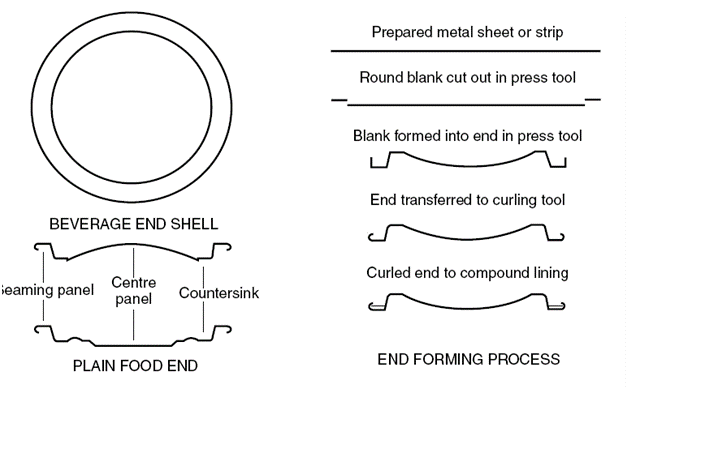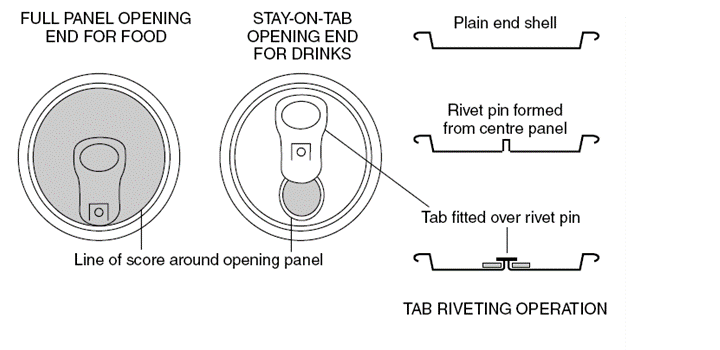Site pages
Current course
Participants
General
Lesson- 11 Metal Containers
11.0 Introduction
The total world market for metal containers is estimated at 410 billion units per annum. Of this, drink cans account for 320 billion and processed food cans account for 75 billion. The remainder is aerosol and general line cans. Drink cans may be divided into those for non-carbonated drinks (liquid coffee, tea, sports drinks etc.) and carbonated beverages (soft drinks and beer), many of which pass through a pasteurization process.
11.1. Raw materials for can-making
Steel and aluminum are used for metal container and closure construction for food and drink products. Both are relatively low-cost materials that are nontoxic, having adequate strength and are capable of being work hardened.
11.1.1. Steel
Steel is used in the form of low-carbon steel which is initially produced as black plate. This is then converted into tinplate or tin-free steel (TFS) for container and closure manufacture. Tinplate is created by electrolytically coating black plate with a thin layer of tin. The tin is coated on both sides of the plate in thickness to suit the internally packed product and the external environment. Different thicknesses of tin may be applied to each side of the plate. Tin, plated in sufficient thickness, provides good corrosion-resisting properties to steel, and is suitable for direct contact with many products including specific foodstuffs such as white fruits (e.g. peaches, apricots, pineapple and pears) and certain tomato-based products (e.g. tomatoes in brine and beans in tomato sauce). However, for most foods and drinks it is necessary to apply an organic coating to the inside surfaces of the tinplate container to provide an inert barrier between the metal and the product packed. This barrier acts to prevent chemical action between the product and container and to prevent taint or staining of the product by direct contact with the metal (see later). The tin surface assists in providing good electrical current flow during welding processes. Being a very soft metal, it also acts as a solid lubricant during the wall ironing process of forming two piece thin wall cans.
11.1.2. Aluminum
Aluminum for light metal packaging is used in a relatively pure form, with manganese and magnesium added to improve the strength properties. This material cannot be welded by can-making systems and can only be used for seamless (two-piece) containers. The internal surfaces of aluminum containers are always coated with an organic lacquer because of the products normally packed.
11.2 Recycling of packaging metal
Both aluminum- and steel-based packaging materials are readily re-melted by the metal manufacturers. Waste materials arising during the can-making processes may be returned for recycling through third party merchants. Postconsumer metal packaging waste is collected and, after automatic separation from other waste materials, is ultimately returned to the metal manufacturers for re-melting. Aluminum and steel suffer no loss of quality during the re-melting process so may be reused an unlimited number of times for the production of first-quality packaging material. Certain recycling processes permit the tin to be separated from the steel base prior to re-melting.
11.3. Can-making
Metal cans are the most common metal containers used for food packaging. The traditional three-piece can (open or sanitary) is still very widely used for heat-processed foods. The cylindrical can body and two ends are made separately. One end is applied to the can body by the can maker, the other (the canners end) by the food processor after the can has been filled with product. The ends are stamped out of sheet metal, the edges curled in and a sealing compound injected into the curl. The body blank is cut from the metal sheet, formed into a cylinder and the lapped, side seam sealed by welding or by polyamide adhesive. Both ends of the cylindrical body are flanged in preparation for the application of the can end. Food and drink cans may be constructed either as three-piece or two-piece containers.
Three-piece cans consist of a cylindrical body rolled from a piece of flat metal with a longitudinal seam (usually formed by welding) together with two can ends, which are seamed onto each end of the body. The three-piece can-making process is very flexible, as it is possible to produce almost any practical combination of height and diameter. This process is particularly suitable for making cans of mixed specifications, as it is relatively simple to change the equipment to make cans of different dimension. Three-piece welded food cans are only constructed from steel, as aluminum is not suitable for welding by this particular process. Coils of steel, after delivery from the steel maker, are cut into sheets approximately 1m2. The cut sheets are then coated, and printed if necessary, to protect and decorate the surfaces. Areas where the weld will be made on the can body are left without coating or print to ensure the weld is always sound. The coatings and inks are normally dried by passing the sheets through a thermally heated oven where the temperature is in the range 150–205°C. Alternatively, for some non-food contact uses, ultraviolet (UV)-sensitive materials may be applied. These are cured instantaneously by passing the wet coating/ink under a UV lamp.
The drawn can (DR can) is a type of two-piece container. The can body and base are made in one operation from a blank metal sheet by being pressed out with a suitable die. The open end of the body is flanged. The can end, manufactured as described above, is applied to the body by double-seaming after the can is filled with product. Because of the strain on the metal, DR cans are shallow with a maximum height: diameter ratio of 1: 2. The drawn and re-drawn can (DRD) is another type of two-piece can. It is made by drawing a cup to a smaller diameter in a series of stages to produce a deeper container than the DR can. The can end is applied to the filled can by double-seaming. DRD cans are usually relatively small, cylindrical and have a height: diameter ratio of up to 1.2: 1.0.The drawn and wall-ironed can (DWI) is made from a disc of metal 0.30–0.42 mm thick. This is drawn into a shallow cup which is forced through a series of ironing rings of reducing internal diameter so that the wall of the cup gets thinner and higher. The top of the body is trimmed, flanged and the end applied by double-seaming after filling the can. Because of the very thin body wall, typically 0.10 mm thick, DWI cans are mainly used for packaging carbonated beverages. The internal pressure supports the thin wall.
The dimensions of cylindrical cans are usually specified in diameter and height, in that order. In many countries the units of diameter and height are millimeters. In the UK and USA inches and 16ths of an inch are used. Thus a can specified as 401/411 has a diameter of 41/16 inches and a height of 411/16 inches. In the case of rectangular or oval cans, two horizontal dimensions must be given.
Other metal containers used for packaging foods include:
- cylindrical cans with a friction plug closure at the canners end, used for dry powders such as coffee and custard powders or for liquids such as syrups and jams;
- rectangular or cylindrical containers with push-on lids, often sealed with adhesive tape, used for biscuits and sweets;
- rectangular or cylindrical containers, incorporating apertures sealed with screw caps, used for liquids such as cooking oils and syrups;
- metal drums used for beer and other carbonated drinks
11.4. End-making processes
11.4.1 Plain food can end and shells for food/drink easy-open ends
The initial processes for making plain food can ends and easy-open ends for food and drink cans are the same. The body of an end that will be ultimately converted into an easy-open end is referred to as a shell. Plain ends/shells may be stamped directly from wide coils of metal or from sheets cut from coils. Whether from coil or sheet, the metal is fed through a press that produces multiple stampings for every stroke.

Figure 11.1: Forming of Plain ends
After removal from the forming tool, the edges of the end shells are then curled over slightly to aid in the final operation of mechanical seaming the end onto the flange of the filled can. After curling, the end shells are passed through a lining machine that applies a bead of liquid-lining compound around the inside of the curl.
11.4.2 Conversion of end shells into easy-open ends
The principles used in the conversion of end shells are the same for both full aperture food easy-open ends and small aperture drink easy-open ends. The conversion operations comprise scoring (partially cutting through) the perimeter of the opening panel and attaching a metal tab with which to tear-open the panel. Scoring is necessary to reduce the force required to open the end to an acceptable level.

Figure 11.2.: Easy-open end conversion
The pull-tab is made from a narrow strip of pre-coated aluminum or steel, which is in coil form. The strip is first pierced and cut, and then the tab is formed in two further stages before it is ready to be joined to the end shell.